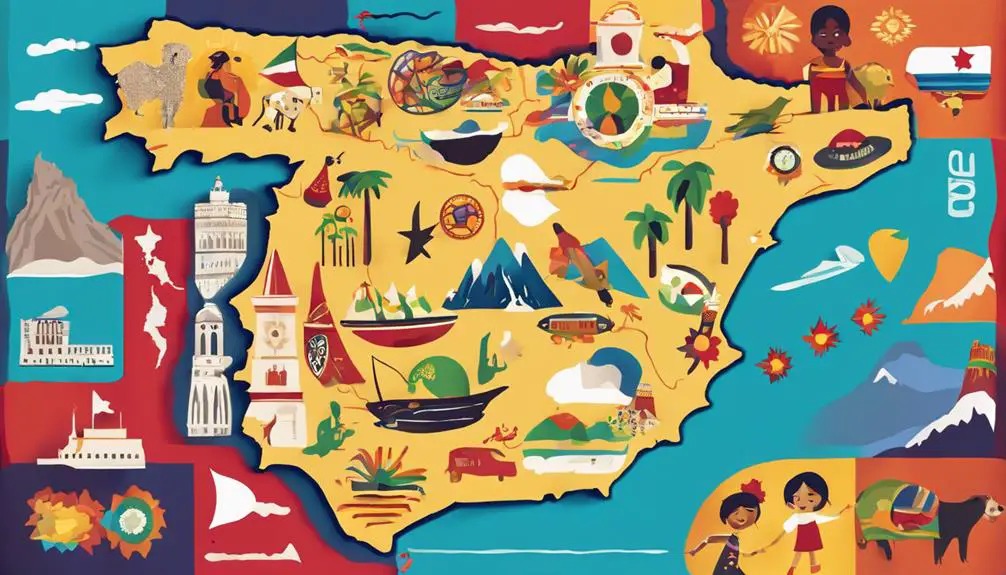When chatting with friends in Spanish, you want to sound cool and casual, right? 'Guay' and 'chido' are your go-to phrases to convey that something is, simply, cool. These expressions are perfect for everyday conversations, helping you sound like a native speaker and building stronger relationships. Using them will make you come across as laid-back and friendly, which is essential in Spanish culture. Dive deeper into the world of Spanish slang and discover more phrases to elevate your conversations and show your appreciation for diverse cultures.
Casual Ways to Say Cool

When hanging out with amigos in a Spanish-speaking country, you'll often hear them use casual expressions to describe something as 'cool,' like 'guay' or 'chido,' which are equivalent to saying 'awesome' or 'sick' in English. These chill phrases give off relaxed vibes, making them perfect for everyday conversations with friends.
You might hear someone say 'Este concierto es guay' (This concert is cool) or 'Este restaurante es chido' (This restaurant is awesome).
When you use these expressions, you'll sound like a native speaker, and your amigos will appreciate your effort to fit in. Remember, in Spanish culture, being relajado (relaxed) is essential, so using casual language helps you blend in. Using 'guay' or 'chido' in the right context will make you sound more laid-back and friendly.
For instance, you can say 'Este parque es guay' (This park is cool) or 'Este café es chido' (This coffee shop is awesome). By incorporating these phrases into your conversations, you'll be well on your way to sounding like a local.
Slang Expressions for Awesome
You'll also come across stronger slang expressions that take 'cool' to the next level, like 'brutal' or 'impresionante,' which pack more punch than 'guay' or 'chido.' These words convey a sense of awe or admiration, and are often used to express excitement or surprise.
For instance, you might say '¡Eso es brutal!' (That's brutal!) to express enthusiasm or approval. These expressions have deep cultural significance, reflecting the emotional intensity and passion that characterize Latin American culture.
Historically, they've roots in the region's rich oral traditions, where storytelling and verbal flair were essential for social bonding and community-building. By using these slang expressions, you'll not only sound more natural and authentic but also tap into the cultural heritage of the Spanish-speaking world.
Cool Phrases for Different Regions

From Mexico to Argentina, different regions in the Spanish-speaking world have their own unique cool phrases that reflect local flavor and attitude. You'll find that regional dialects and cultural nuances shape the way people express themselves.
For instance, in Mexico, 'chido' is a popular phrase to express admiration, while in Argentina, 'che' is a common way to address friends. In coastal regions, you'll pick up on the laid-back vibes, where phrases like 'relajado' (relaxed) or 'tranquilo' (chill) are often used to describe the atmosphere.
In Colombia, 'parce' is a term of endearment, similar to 'buddy' or 'pal.' When interacting with locals, using these regional phrases will help you connect on a deeper level and show appreciation for their culture. By embracing these regional dialects, you'll sound more natural and build stronger relationships.
Using ¡Guay! in Conversations
In informal gatherings and casual chats, ¡guay! is a versatile expression that can add a touch of excitement and enthusiasm to your conversations. When used correctly, it can convey your excitement, surprise, or agreement. However, understanding the nuances of using ¡guay! is crucial to avoid coming across as insincere or overusing it.
Here are some guidelines to keep in mind:
| Situation | When to use ¡guay! | Guay Etiquette |
|---|---|---|
| Expressing excitement | When you're genuinely thrilled | Use it sparingly to avoid overemphasis |
| Showing agreement | When you strongly agree | Avoid using it with strangers or in formal settings |
| Reacting to news | When you're surprised or impressed | Be mindful of the tone and volume |
| In casual conversations | With friends or acquaintances | Be authentic and avoid overusing it |
| In formal settings | Avoid using it altogether | Stick to more formal expressions |
That's Cool in Latin American Slang

Across Latin America, locals often use expressions like 'chévere' in Venezuela, 'bacano' in Chile, or 'chido' in Mexico to convey that something is cool. Mastering these regional phrases can help you better connect with the culture.
When you're traveling or living in Latin America, using the right slang can make a big difference in your interactions with locals. You'll sound more natural and show respect for the local culture.
For instance, in Argentina, you can say 're copado' to express admiration, while in Colombia, 'rumbear' means to have a great time. Understanding these Latin dialects and their cultural nuances will help you navigate everyday conversations with ease.
Expressing Excitement in Spanish
You'll likely find yourself in situations where you want to express excitement or enthusiasm in Spanish, whether it's cheering on your favorite soccer team or reacting to a thrilling experience. When expressing excitement, it's crucial to take into account the cultural nuances of the Spanish-speaking world.
In Spain, for instance, you might use '¡Esto es increíble!' (This is incredible!) or '¡Es emocionante!' (It's exciting!). In Latin America, you could say '¡Esto es emocionante!' or '¡Es una pasada!' (It's a blast!).
When conveying emotional intensity, use phrases like '¡Me encanta!' (I love it!) or '¡Estoy emocionado/a!' (I'm excited!). To add more emphasis, you can use superlatives like '¡Es lo mejor!' (It's the best!) or '¡Es increíblemente divertido!' (It's incredibly fun!).
Remember that cultural nuances can vary greatly across different regions, so it's crucial to be mindful of your audience and adjust your language accordingly. By mastering these expressions, you'll be able to convey your excitement and enthusiasm like a native Spanish speaker.
Everyday Cool Phrases to Know

While maneuvering through daily conversations in Spanish, you'll want to sprinkle your speech with cool phrases that make you sound like a local. These everyday cool phrases will help you navigate Cool Conversations with ease.
Start by incorporating daily expressions like '¿Qué onda?' (what's up?) or '¿Cómo vas?' (how's it going?) into your conversations. You can also use phrases like '¡Hasta luego!' (see you later!) or '¡Chau!' (bye!) to wrap up a conversation.
When expressing agreement or confirmation, use '¡Claro!' (of course!) or '¡Exacto!' (exactly!). For added flair, throw in some casual phrases like '¡No way, José!' (no way!) or '¡Eso es verdad!' (that's true!).
These phrases will help you sound more natural and relaxed in your conversations. Remember, the key to Cool Conversations is to sound authentic and effortless. By incorporating these daily expressions into your speech, you'll be well on your way to sounding like a native Spanish speaker.
Mastering the Art of Cool Responses
Mastering the art of cool responses requires a deep understanding of Spanish slang and colloquialisms. You're not just learning phrases; you're adopting a cultural attitude.
To truly embody the essence of 'cool' in Spanish, you need to know when to use the right phrases, tone, and body language. It's about exuding confidence and youthful vibes.
When responding to a situation, you want to come across as relaxed and laid-back. Moving smoothly is key. For instance, if someone asks you to hang out, you can respond with '¿Qué onda?' (what's up?) or '¡Vamos a ver!' (let's see!). These phrases convey a sense of casualness and flexibility.
Remember, it's not just about the words; it's about the tone and attitude behind them.
When you master the art of cool responses, you'll find yourself effortlessly gliding through everyday conversations. You'll be the one who always knows what to say, and people will appreciate your chill and laid-back demeanor.
Frequently Asked Questions
Is "Guay" a Universally Accepted Cool Slang in Spanish?
You're wondering if 'guay' is a universally accepted cool slang in Spanish. Well, the answer is, it depends on the region.
While 'guay' is widely used in some Latin American countries, it's not as common in others. Regional variations in slang evolution mean that what's cool in one place mightn't be in another.
You'll need to adapt to local lingo to truly be 'guay' – or cool – in every sense.
Can I Use "Ché" in Formal Conversations in Argentina?
You're likely to encounter 42 million Spanish speakers in Argentina, and when communicating with them, etiquette matters.
When it comes to using 'ché' in formal conversations, it's generally best to avoid it. While 'ché' is a common expression in informal settings, it's not suitable for business communication in Argentina. Stick to formal language to show respect and professionalism.
Save 'ché' for casual chats with friends, and opt for a more polished tone in formal Argentine etiquette.
Is "Chido" Only Used in Mexico or Other Countries Too?
You're wondering if 'chido' is exclusive to Mexico or used elsewhere. While it's true that 'chido' is a popular slang term in Mexico, you'll also find variations of it in other countries.
In Chile, for instance, 'chido' means 'good' or 'cool.' Regional dialects play a significant role in shaping the usage of 'chido' and its variations. You'll find that its meaning and usage differ across countries, making it essential to understand the local context when using this term.
Can "Bacano" Be Used to Describe a Person's Attitude?
Imagine you're dancing to the rhythm of Latin American streets, where 'bacano' is the secret ingredient that spices up the atmosphere. Can you use it to describe a person's attitude? Absolutely!
Bacano behavior exudes cool vibes, like an invigorating breeze on a hot summer day. It's about being laid-back, confident, and effortlessly chic. You can say, 'Ese tipo es bacano' (That guy's got swag), or 'Me encanta su actitud bacana' (I love their cool attitude).
Bacano is the epitome of Latin cool.
Is "Piola" Used in Spain or Only in Latin America?
You're wondering if 'piola' is used in Spain or only in Latin America.
The answer lies in the origins of the word. Piola is a colloquialism originating in Argentina and Uruguay, specifically in the Lunfardo dialect.
It's not commonly used in Spain, where different dialects and slang prevail.
While piola has spread to other Latin American countries, it's not a part of everyday language in Spain, where you're more likely to hear other expressions to convey 'cool' or 'awesome'.
Conclusion
You've mastered the art of being cool in Spanish slang! Now, go forth and casually throw around 'guay' and 'chido' like a native.
But, let's be real, you're probably still going to accidentally use 'cool' in English when you mean to say 'fresco' or 'chido'. Don't worry, it's a process.
Just remember, in Latin America, 'guay' is your go-to, while in Spain, 'guay' is, well, not so cool. Embrace the irony, and own that awkward phase – it's all part of being cool, right?







